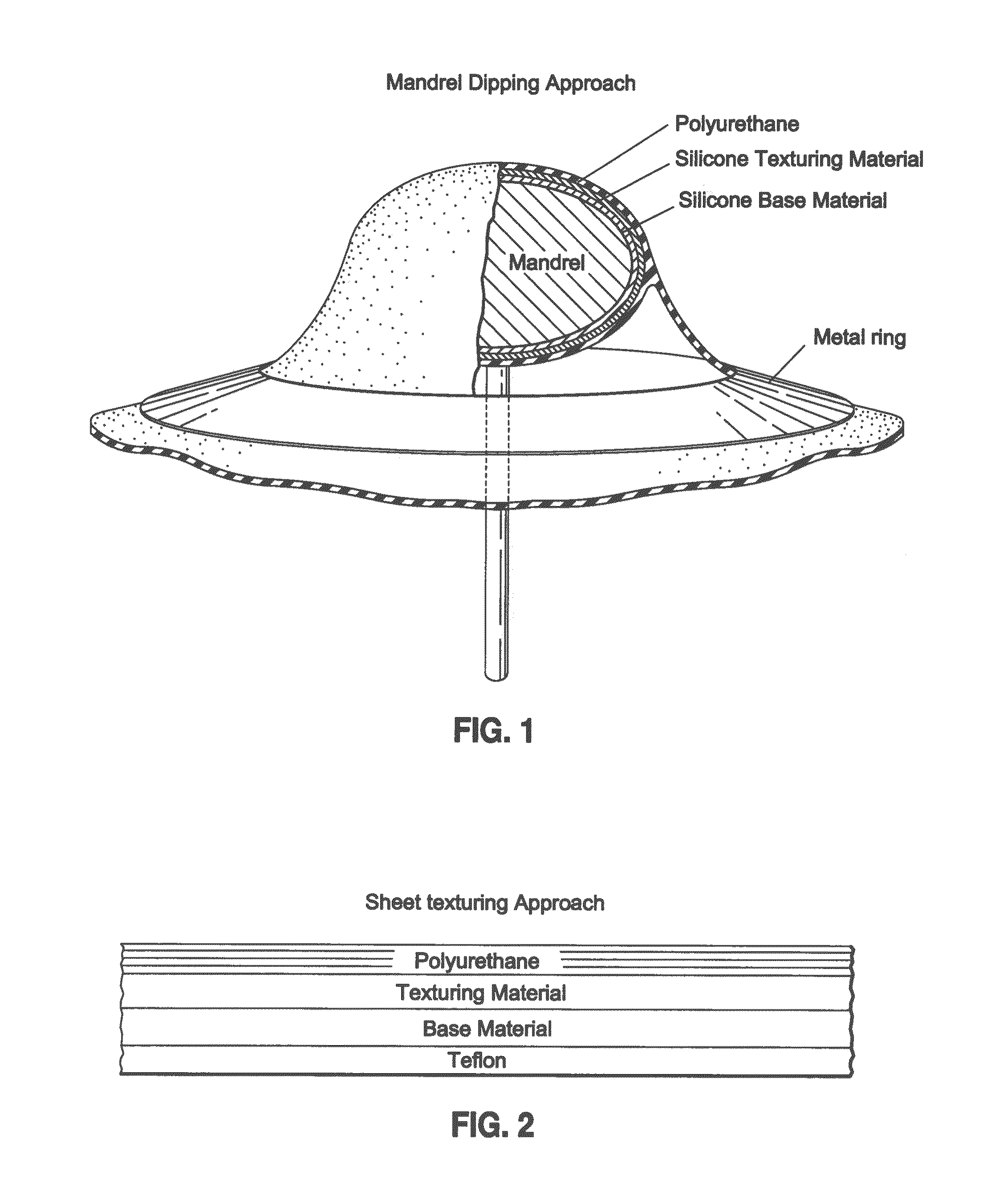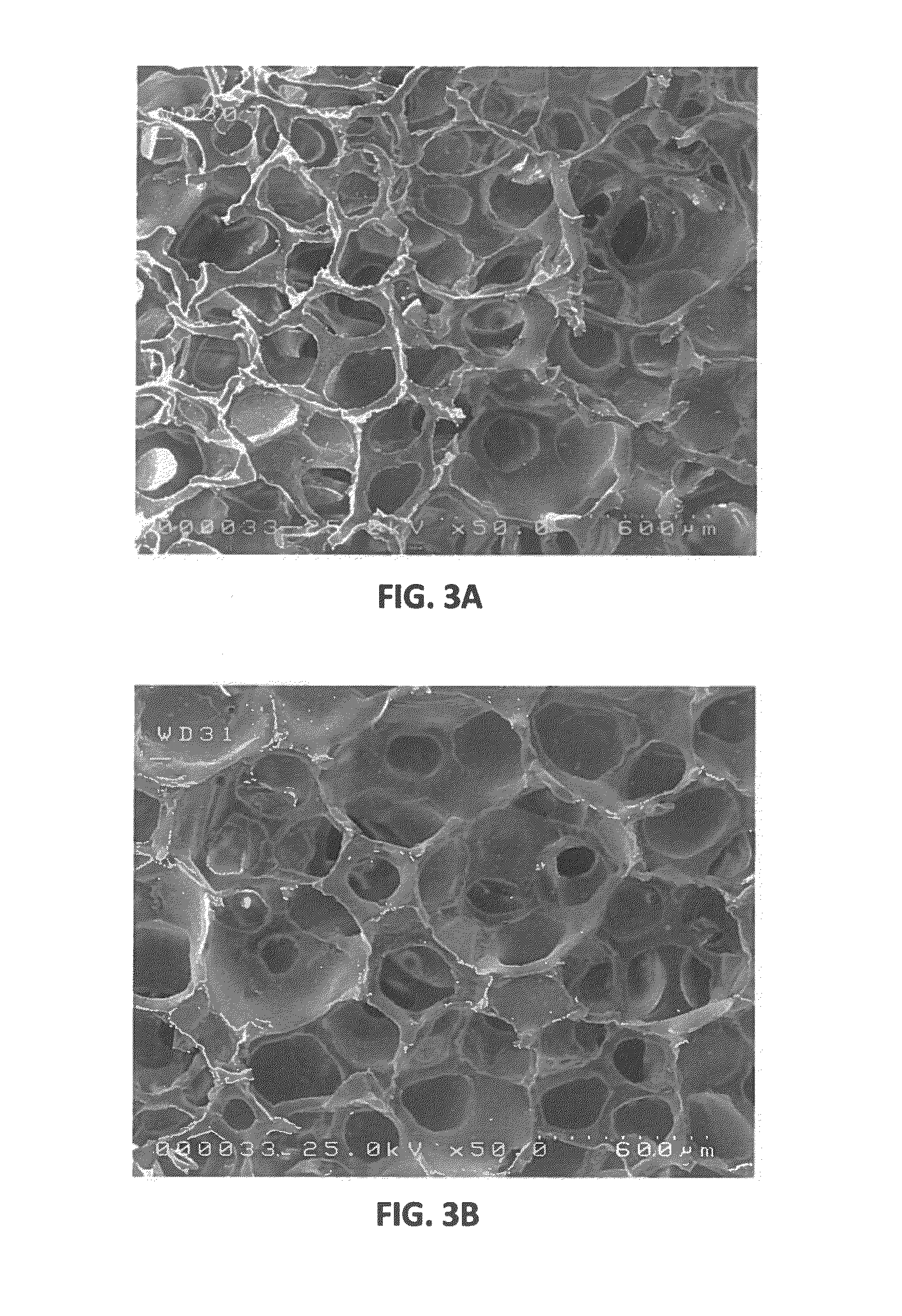Methods for creating foam-like texture
a foam-like texture and texture technology, applied in the field of methods for creating foam-like textures, can solve the problems of discomfort or even extreme pain, distortion of the appearance of augmented or reconstructed breasts,
- Summary
- Abstract
- Description
- Claims
- Application Information
AI Technical Summary
Benefits of technology
Problems solved by technology
Method used
Image
Examples
example 1
[0069]Uncured Room-Temperature-Vulcanizing (“RTV”) silicone, for example, MED-1511, is spread onto a mandrel of a desired shape as a layer having a thickness of 200 μm. A polyurethane foam is placed over the RTV silicone and the mandrel with the aid of metal rings which clamp the foam in place. The weight of the metal rings asserts a force of approximately 30 psi against the polyurethane foam, the RTV silicone and the mandrel. After the RTV silicone is cured, the metal ring and mandrel are removed from the composite of the cured RTV silicone and polyurethane foam. The composite of the cured RTV silicone and polyurethane foam is submerged in hydrochloric acid for five minutes to remove the polyurethane foam. Excess hydrochloric acid is removed by washing in distilled water for two minutes. The resulting product is a silicone material having a foam-like texture.
example 2
[0070]A base coat of uncured High-Temperature-Vulcanizing (“HTV”) silicone dispersed in xylene, for example, MED-6400 dispersed in xylene, is spread onto a mandrel and cured (in FIG. 1, the “silicone base material”). The mandrel covered by a base coat is then dipped in a second uncured HTV silicone dispersed in xylene (in FIG. 1, the “silicone texturing material”), for example, MED 6640 in xylene, until the second coat of HTV silicone dispersed in xylene reaches a thickness of (about) 250 μm. Then the xylene is removed from the HTV silicone materials by devolatilization in a fume hood. Next, a piece of polyurethane foam is placed over and pressed down against the HTV-silicone-coated mandrel. One way to apply the polyurethane foam to the HTV-silicone-coated mandrel is to clamp the foam between metal rings (see FIG. 1), then place the exposed portion of the foam that is circumscribed within the rings over the mandrel; the metal rings immobilize the foam to keep it in place and press t...
example 3
Silicone Sheet Approach
[0071]An uncured silicone material (1 mm thick, 5″×5″), such as MED-4815 dispersed in xylene (50 ml, 30% w / w), is cast onto a Teflon sheet on the surface of a film coater. After the film coater creates an even sheet of the silicone, the Teflon sheet is taken off of the film coater and the silicone is cured in an oven at 126° C. for 2 hours. The Teflon sheet with the cured, first layer is then placed back on the film coater. Then, an uncured, second layer of silicone material, which may be the same material as the cured, first layer, is spread onto the surface of the cured, first layer. The film coater creates an even sheet of the uncured second layer of silicone. The Teflon sheet is then removed from the film coater and placed in a mechanical press. Next, polyurethane foam is placed over the uncured, second layer of silicone material and, using the press set to 50 psi, the polyurethane foam is pressed into the uncured silicone for 1 minute, which results in a ...
PUM
| Property | Measurement | Unit |
|---|---|---|
| thickness | aaaaa | aaaaa |
| thickness | aaaaa | aaaaa |
| pressure | aaaaa | aaaaa |
Abstract
Description
Claims
Application Information
 Login to View More
Login to View More - R&D
- Intellectual Property
- Life Sciences
- Materials
- Tech Scout
- Unparalleled Data Quality
- Higher Quality Content
- 60% Fewer Hallucinations
Browse by: Latest US Patents, China's latest patents, Technical Efficacy Thesaurus, Application Domain, Technology Topic, Popular Technical Reports.
© 2025 PatSnap. All rights reserved.Legal|Privacy policy|Modern Slavery Act Transparency Statement|Sitemap|About US| Contact US: help@patsnap.com



